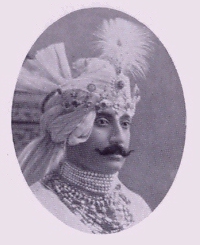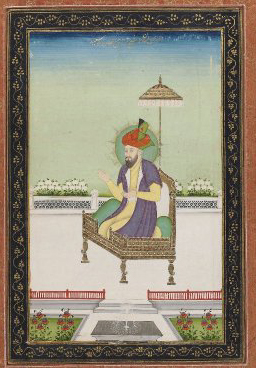
Babur, born Zahīr ud-Dīn Muhammad, was the founder of the Mughal Empire in the Indian subcontinent. He was a descendant of Timur and Genghis Khan through his father and mother respectively. He was also given the posthumous name of Firdaws Makani.

Fath-Ali Shah Qajar was the second Shah (king) of Qajar Iran. He reigned from 17 June 1797 until his death on 24 October 1834. His reign saw the irrevocable ceding of Iran's northern territories in the Caucasus, comprising what is nowadays Georgia, Dagestan, Azerbaijan, and Armenia, to the Russian Empire following the Russo-Persian Wars of 1804–1813 and 1826–1828 and the resulting treaties of Gulistan and Turkmenchay. Historian Joseph M. Upton says that he "is famous among Iranians for three things: his exceptionally long beard, his wasp-like waist, and his progeny."

Muhammad Shaybani Khan, was an Uzbek leader who consolidated various Uzbek tribes and laid the foundations for their ascendance in Transoxiana and the establishment of the Khanate of Bukhara. He was a Shaybanid or descendant of Shiban, the fifth son of Jochi, Genghis Khan's eldest son. He was the son of Shah-Budag, thus a grandson of the Uzbek conqueror Abu'l-Khayr Khan.

Nawab Begum Sajida Sultan Ali Khan Pataudi was the daughter of the Nawab of Bhopal, Hamidullah Khan, and the wife and Begum Consort of Iftikhar Ali Khan Pataudi, the 8th Nawab of Pataudi, and in her own right, the 12th Nawab Begum of Bhopal.
Ahmad Alaq was the Khan of Eastern Moghulistan from 1487 to 1504. He was the second son of Yunus Khan. His mother was Shah Begum, fourth daughter of Badakhshan prince Lali.

Kamran Mirza was the second son of Babur, the founder of the Mughal Empire and the first Mughal Emperor. Kamran Mirza was born in Kabul to Babur's wife Gulrukh Begum. He was half-brother to Babur's eldest son Humayun, who would go on and inherit the Mughal throne, but he was full-brother to Babur's third son, Askari. A divan written in Persian and Chagatai is attributed to him.
Amin ud-din Ahmad Khan was the last ruling Nawab of princely state of Loharu, reigning from 1926 to 1947.

Heena is a Hindi TV serial that aired on Sony Entertainment Television. The series began to air from 12 June 1998 and ran for five years, finishing on 11 July 2003. The series was telecasted on every Friday at 9:30 pm (IST). The opening theme song for the serial was taken from a Ghazal sung by Jagjit Singh titled as Koi Yeh Kaise Bataye

Nawab Sir Sayyid Hassan Ali Mirza Khan Bahadur was the eldest son of Mansur Ali Khan, the last Nawab of Bengal. He succeeded his father, Mansur Ali Khan, as the first Nawab Bahadur of Murshidabad as the title of Nawab Nazim of Bengal was abolished in 1880. His installation ceremony was performed in the Throne Room of Hazarduari Palace on 27 March 1883 by Sir Rivers Thompson, the Lieutenant-Governor of Bengal. The sanad conferring the hereditary title of Nawab Bahadur of Murshidabad was however dated 17 February 1882. At his death in 1906, he was succeeded by his son, Wasif Ali Mirza.

Sir Sayyid Wasif Ali Mirza Khan Bahadur was the Nawab of Murshidabad during 1906–1959. Sir Wasif Ali Mirza was educated at Sherborne School, Rugby School and later at Trinity College. He succeeded his father Hassan Ali Mirza Khan Bahadur at his death on 25 December 1906. On 11 December 1931, Wasif Ali was forced to surrender the administration of his estates to the Government of India after incurring a debt of ₹19 lakhs. On 15 August 1947, the Radcliffe Award allotted the district of Murshidabad to Pakistan and the flag of Pakistan was hoisted at the Hazarduari Palace but within two days the two dominions exchanged Khulna, which is now in Bangladesh, and then the flag of India was hoisted at the grand palace on 17 August 1947. The Government of India also resumed him all his estates in 1953. Wasif Ali was also the founder and president of the Hindu–Muslim Unity Association in the year 1937, named Anjuman-e-Musalman-e-Bangla, which promoted Hindu–Muslim unity. The Nawab also built the Wasif Manzil.
Semidelitschia is a genus of coprophilous fungi in the family Delitschiaceae that contains three species. Semidelitschia was circumscribed in 1969 by mycologists Roy Cain and Robena Luck-Allen to contain the type species, Semidelitschia agasmaticaCain & Luck-Allen, found in North America. Semidelitschia tetrasporaJ.H. Mirza & S.M. Khan and Semidelitschia nanostellataA.E. Bell & Mahoney were added to the genus in 1979 and 2001, respectively. The genus is characterized by species with one-celled, dark ascospores, which distinguishes it from the related genus Delitschia (Delitschiaceae), which have two-celled ascospores.

Podospora is a genus of fungi in the family Podosporaceae. Fossils of Podospora have been reported from 12 million year old rocks from central England.

Umar Shaikh Mirza II was the ruler of the Fergana Valley. He was the fourth son of Abu Sa'id Mirza, the emperor of the Timurid Empire in what is now Kazakhstan, Uzbekistan, Afghanistan and eastern Iran.
Sultan Ahmed Mirza was the eldest son of Abu Sa'id Mirza on whose death he became the Timurid ruler of Samarkand and Bukhara from 1469 until 1494. During his rule, he successfully repelled at least one invasion attempt by the Kara Koyunlu, and failed in an attempt to conquer Khurasan from its ruler Sultan Husayn Mirza Bayqara. He was embroiled in the Timurid Civil Wars with his brothers Umar Shaikh Mirza II and Sultan Mahmud Mirza. He died while returning from his Ferghana expedition against Babur, the twelve-year-old son and successor of Umar Shaikh Mirza II. As he had no male heir, he was succeeded by his brother, Sultan Mahmud Mirza.

Salima Sultan Begum was the third wife and chief consort of the Mughal emperor Akbar, and the granddaughter of Babur.

Khanzada Begum was a Timurid princess and the eldest daughter of Umar Shaikh Mirza II, the amir of Ferghana. She was also the elder sister of Babur, the founder of the Mughal Empire. She and her brother remained deeply attached to each other all their lives, a period during which the family progressed from ruling a tiny and obscure principality in Central Asia to ruling a large portion of the Indian subcontinent. Babur conferred on his sister, the honorable title of Padshah Begum and she was really the first lady of his Empire after his death.
Shah Begum was the Queen consort of Moghulistan as the second wife of Yunus Khan, a descendant of Chaghatai Khan, the second son of Genghis Khan. She was the mother of Mahmud Khan and Ahmad Alaq, the next Moghul Khans of Moghulistan.
Lichtheimiaceae is a family of fungi in the order Mucorales. The family was circumscribed in 2013 after a molecular phylogenetic analysis helped delineate a new family structure for the Mucorales.
Zair, Zabar, Pesh is a 1974 Pakistani television series written by Haseena Moin and directed by Ishrat Ansari and produced by Shireen Khan and Zaheer Khan.












